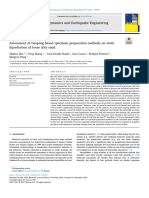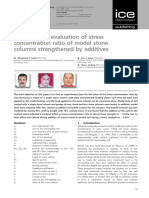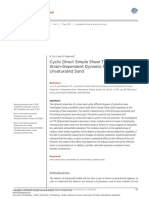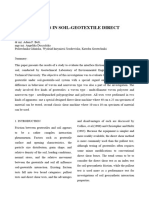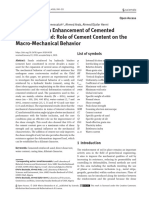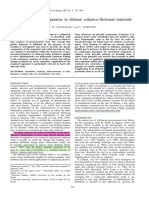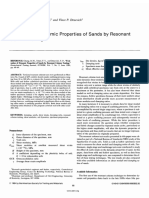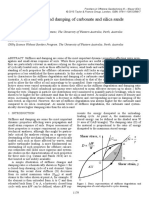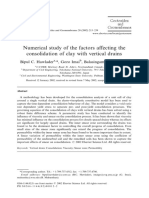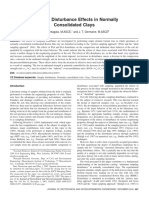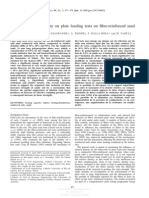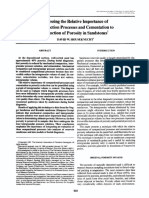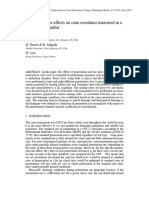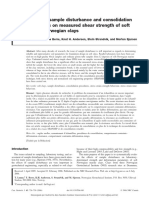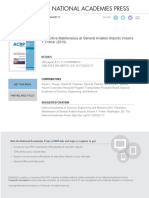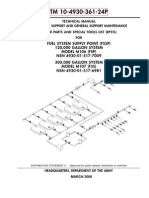Fracture Processes: Residual Strength of Kaolin and Bentonite: The Influence of 951056
Fracture Processes: Residual Strength of Kaolin and Bentonite: The Influence of 951056
Uploaded by
Issam SembatiCopyright:
Available Formats
Fracture Processes: Residual Strength of Kaolin and Bentonite: The Influence of 951056
Fracture Processes: Residual Strength of Kaolin and Bentonite: The Influence of 951056
Uploaded by
Issam SembatiOriginal Title
Copyright
Available Formats
Share this document
Did you find this document useful?
Is this content inappropriate?
Copyright:
Available Formats
Fracture Processes: Residual Strength of Kaolin and Bentonite: The Influence of 951056
Fracture Processes: Residual Strength of Kaolin and Bentonite: The Influence of 951056
Uploaded by
Issam SembatiCopyright:
Available Formats
8A PROPERTIES:FRACTURE PROCESSES
Compaction tests (isotropic drained loading) were conducted 951055
on randomly packed glass beads that were: 1) uncemented Resifient modulus for fine-grained subgrade soils
and 2) cemented by epoxy at their contacts. In the latter case, Dingqing Li & T. Selig, Journal of Geotechnical Engineering.
the volume of the epoxy accounted for 10% of the pore space. ASCE, 120(6), 1994, pp 939-957.
Intensive crushing of grains was observed in the first case at
about 50 MPa. In the second case, the cemented grains stayed A method has been developed for the estimation of resilient
intact, the failure being localized within the epoxy. Therefore, modulus of compacted fine-grained subgrade soils. The
even small amounts of cement at contacts prevent the failure method takes into account the influence of soil physical
of grains. Theoretically, this effect follows from the theory of state, stress state, and soil type. The effect of soil physical
cemented granular materials: stress concentration is high at state is quantified by combinations of two equations relating
the contacts of uncemented grains, whereas even small resilient modulus to moisture content. The effect of stress
amounts of relatively soft cement result in a more uniform state is determined by equations relating resilient modulus at
stress distribution over a larger contact area. (Authors) optimum moisture content to deviator stress so that the
equation parameters represent the effect of soil type and its
structure. Means to estimate the resilient modulus at
optimum moisture content are suggested in the absonce of
951052 actual test data. (from Authors)
Residual strength of kaolin and bentonite: the influence of
their constituent pore fluid
C. Di Maio & G. B. Fenelli, Geoteehnique, 44(2), 1994, pp 951056
217-226. Stress-path dependent shear strength of sand
This paper investigates further the roles of minerals and pore J. Feda, Journal of Geotedmical Engineering- ASCE, 120(6),
fluid composition on the residual strength of clayey soils. It 1994, pp 958-974.
describes and analyses tests on kaolin, bentonite and their Failure envelopes of sands are often considered to he
mixtures exposed to distilled water and sodium chloride nonlinear depending both on relative density and stress
solutions with given concentrations. The results show that the level. Triaxial tests that were performed on clean alluvial-
shear strength of kaolin is not affected by the solutions used, quartzitic Zbraslav sand were used for analyzing the form of
whereas the residual strength of bentonite varies greatly the failure envelope. In addition to relative density and stress
because of the inward salt diffusion towards the clay. Further, level, the stress path has been found to affect the shear
for the clay mixtures with any of the pore fluids considered, resistance as well. Only tests with constant-mean stress
the weaker component has the greater influence on the produce nonlinear-failure envelopes. Up to the peak-stress
hehaviour of the mixture. (from Authors) difference, no shear bands were observed. Rough platens were
used to simplify the procedure since the specimen's restraint
was found not to affect the shear resistance for diameter to
951053 height ratio 1:2. (from Authors)
Shear modulus of kaolin containing methane bubbles
S. M. Duffy, S. J. Wheeler & J. D. Bennell, Journal of
Geotechnical Engineering - ASCE, 120(5), 1994, pp 781-796. Fracture processes
Measurements of undrained shear moduli are reported from a
program of laboratory tests on reconstituted kaolin samples
containing relatively large bubbles of methane gas. At all 951057
values of strain amplitude, the reduction of shear moduli Numerical simulation of fracture set formation: a fracture
caused by the presence of gas bubbles was greater than mechanics model consistent with experimental observations
predicted by a theoretical elastic expression. This pattern of C. E. Renshaw & D. D. Pollard, Journal of Geophysical
behavior was attributed to the formation of local yield zones Research, 99(B5), 1994, pp 9359-9372.
around the gas-bubble cavities during consolidation prior to
shear testing (a phenomenon that would also occur in-situ A physically based model for the evolution of a single set of
within offshore sediments). The results suggest that reduc- planar, parallel fractures subject to a constant remote stress is
tions in shear moduli of up to 50% could be caused by presented. The model simulates the mechanical interaction
relatively small volumes of gas bubbles, occupying just a few between fractures using a recently developed approximation
percent of the total soil volume. This would have considerable technique for stress analysis in elastic solids with many
significance for the displacements of offshore foundations fractures. A comparison between experimental and numerical
constructed on sediments containing undissolved gas. (from results shows that the model can accurately simulate the
Authors) development of experimentally generated fracture sets. (from
Authors)
951054 951058
Drained residual strength of cohesive soils Fracture toughness of compacted cohesive soils using ring
T. D. Stark & H. T. Eid, Journal of Geotechnical Engineering test
- ASCE, 120(5), 1994, pp 856-871. J. A. Harison, B. O. Hardin & K. Mahboub, Journal of
Results of torsional ring shear tests on cohesive soils reveal Geotechnical Engineering - A$CE, 120(5), 1994, pp 872-891.
that the drained residual strength is related to the type of clay Testing procedures and methods of analysis for determining
mineral and quantity of clay-size particles. The liquid limit is the fracture toughness of soils using the ring test are described
used as an indicator of clay mineralogy, and the clay-size and values of fracture toughness measured for 132 compacted
fraction indicates quantity of particles smaller than 0.002 ram. specimens of two cohesive soils are presented. The critical
Therefore, increasing the liquid limit and clay-size fraction mode I stress-intensity factor, the critical I integral, and the
decreases the drained residual strength. The ring shear tests tensile strength can he determined simultaneously from a
also reveal that the drained residual failure envelope is single ring-test specimen. A strong correlation between
nonlinear, and the nonlinearity is significant for cohesive soils fracture toughness and ring-specimen tensile strength was
with a clay-size fraction greater than 50% and a liquid limit found. Effects of material type, water content, soil-placement
between 60% and 220%. This nonlinearity should be conditions, rate of loading, and specimen size have been
incorporated into stability analyses. (from Authors) studied, and values of fracture toughness measured by
You might also like
- Effecto of Powderfactor and Timing On The Impacto Brakage of RocksDocument12 pagesEffecto of Powderfactor and Timing On The Impacto Brakage of Rocksmiguel humpire huamani100% (1)
- Coding Assign 1Document2 pagesCoding Assign 1Issam SembatiNo ratings yet
- Tennyson's The Brook - Analysis and SummaryDocument9 pagesTennyson's The Brook - Analysis and Summarypurplerain734100% (8)
- Erosion Del Suelo 4Document7 pagesErosion Del Suelo 4ccbhNo ratings yet
- Failure Envelope of Artificially Cemented SandDocument5 pagesFailure Envelope of Artificially Cemented SandFelicioSantosNo ratings yet
- Effect of Strain Rate On Shear Strength Parameter of Sand: December 2015Document9 pagesEffect of Strain Rate On Shear Strength Parameter of Sand: December 2015Susmita PandaNo ratings yet
- Wang CementationDocument16 pagesWang Cementationj_brug571No ratings yet
- 263 006 PDFDocument13 pages263 006 PDFCharme LangaNo ratings yet
- ISOPE-I-95-060Document8 pagesISOPE-I-95-060raghumahadevappaNo ratings yet
- Assessment of tamping-based specimen preparation methods on staticDocument10 pagesAssessment of tamping-based specimen preparation methods on staticYutang ChenNo ratings yet
- Rayhani El Naggar 2008 Seismic Response of Sands in Centrifuge TestsDocument14 pagesRayhani El Naggar 2008 Seismic Response of Sands in Centrifuge Testsnhan nguyenNo ratings yet
- Experimental Evaluation of Stress ConcenDocument20 pagesExperimental Evaluation of Stress ConcenmakiNo ratings yet
- Cyclic Direct Simple Shear Test To Measure Strain-Depandent Dynamic Properties of Unsaturated SandDocument15 pagesCyclic Direct Simple Shear Test To Measure Strain-Depandent Dynamic Properties of Unsaturated SandNaveen KanwatNo ratings yet
- Determination of Shear Modulus of Soil From Static and Seismic Penetration TestingDocument19 pagesDetermination of Shear Modulus of Soil From Static and Seismic Penetration TestingHüseyin EkiciNo ratings yet
- Scale Effects 1996Document11 pagesScale Effects 1996Angelika DuszyńskaNo ratings yet
- 2015 Determination of Shear ModulusDocument19 pages2015 Determination of Shear ModulusCandra Ismail AlhakimNo ratings yet
- Effect of Particle Crushing On Shear Strength andDocument13 pagesEffect of Particle Crushing On Shear Strength andMeral KayaNo ratings yet
- Shrinkage Behavior of Foam Concrete E. K Kunhanandan Nambiar, K. RamamurthyDocument25 pagesShrinkage Behavior of Foam Concrete E. K Kunhanandan Nambiar, K. RamamurthyThippeswamy G N ThippuNo ratings yet
- Icsmge 2022-68Document7 pagesIcsmge 2022-68fraztyaNo ratings yet
- SBPM Testing in Bothkennar Clay Structure EffectsDocument8 pagesSBPM Testing in Bothkennar Clay Structure Effectssgaluf5No ratings yet
- 10.2478 - Sgem 2019 0020Document12 pages10.2478 - Sgem 2019 0020miloud_flittiNo ratings yet
- Efeito da expansão de cavidades na argilaDocument11 pagesEfeito da expansão de cavidades na argilaAlex CrispimNo ratings yet
- Han Et Al 2008Document7 pagesHan Et Al 2008B RAMUNo ratings yet
- Mántaras, Schnaid. 2002. Cylindrical Cavity Expansion in Dilatant Cohesive-Frictional Materials SUBDocument12 pagesMántaras, Schnaid. 2002. Cylindrical Cavity Expansion in Dilatant Cohesive-Frictional Materials SUBDavid Eduardo LourençoNo ratings yet
- 1984-RM Chung EvaluationofDynamicPropertiesofSandsbyResonantColu (Retrieved 2021-10-31)Document10 pages1984-RM Chung EvaluationofDynamicPropertiesofSandsbyResonantColu (Retrieved 2021-10-31)Anonymous cPlDZyDNo ratings yet
- 2022-Kuhn Et Al - Mechanical Behaviour KaolinDocument12 pages2022-Kuhn Et Al - Mechanical Behaviour KaolinnsanieleNo ratings yet
- 2015CarraroBortolotto PDFDocument5 pages2015CarraroBortolotto PDFSelvaganeshNo ratings yet
- Effective Stress Analysis For The Seismic Response of Shallow Foundations On Liquefiable SandDocument6 pagesEffective Stress Analysis For The Seismic Response of Shallow Foundations On Liquefiable SandLaboratoire LTGCNo ratings yet
- Literature ReviewDocument18 pagesLiterature ReviewSanjay KiradooNo ratings yet
- Creep - Effect of Loading Strain On Creep and Stress RelaxationDocument5 pagesCreep - Effect of Loading Strain On Creep and Stress RelaxationTONNY LESMANANo ratings yet
- Stone Columns As Liquefaction Countermeasure in Non-Plastic Silty SoilsDocument14 pagesStone Columns As Liquefaction Countermeasure in Non-Plastic Silty SoilsManaswini VadlamaniNo ratings yet
- Discrete Element Simulation of Crushable Soil: Géotechnique January 2003Document10 pagesDiscrete Element Simulation of Crushable Soil: Géotechnique January 2003Cesar HernandezNo ratings yet
- Dynamic Behavior of Fiber-Reinforced Soil Under Freeze-Thaw CyclesDocument16 pagesDynamic Behavior of Fiber-Reinforced Soil Under Freeze-Thaw CyclesMuheebNo ratings yet
- Comparative Study of Defferent Subbase MaterialsDocument7 pagesComparative Study of Defferent Subbase Materialsmohammad yaseenNo ratings yet
- 2024 BanerjeeDocument16 pages2024 BanerjeeMujeeb Ul RehmanNo ratings yet
- Computers and Geotechnics: Zhiwei Gao, Jidong ZhaoDocument13 pagesComputers and Geotechnics: Zhiwei Gao, Jidong ZhaorkNo ratings yet
- 2015 Determination of Shear ModulusDocument19 pages2015 Determination of Shear Modulusbobedula21No ratings yet
- Numerical Study of The Factors Affecting The Consolidation of Clay With Vertical DrainsDocument27 pagesNumerical Study of The Factors Affecting The Consolidation of Clay With Vertical DrainsIntishar RahmanNo ratings yet
- Haddad, Attar e Fakharian 2012Document7 pagesHaddad, Attar e Fakharian 2012José da SilvaNo ratings yet
- Cruz Nuno 2012 ISC4 Cement by DMTDocument6 pagesCruz Nuno 2012 ISC4 Cement by DMTxfvgNo ratings yet
- Effect of Shear Strain CompatiDocument26 pagesEffect of Shear Strain Compaticaptain.binkhaterNo ratings yet
- Santagata, Germaine - 2002 - Sampling DisturbaDocument10 pagesSantagata, Germaine - 2002 - Sampling DisturbaVIGNOLLES GroupNo ratings yet
- Triaxial Testing of Granular Soil (Colliat-Dangus, 1988)Document21 pagesTriaxial Testing of Granular Soil (Colliat-Dangus, 1988)Abraham FIgueroa ARevaloNo ratings yet
- In Fluence of The Manufacturing Process On The Performance of Low Clinker, Calcined Clay-Limestone Portland CementDocument7 pagesIn Fluence of The Manufacturing Process On The Performance of Low Clinker, Calcined Clay-Limestone Portland CementVictor RodrigoNo ratings yet
- Effect of Relative Density On Plate Loading Tests On Fibre-Reinforced SandDocument6 pagesEffect of Relative Density On Plate Loading Tests On Fibre-Reinforced Sandmarcos_samudioNo ratings yet
- Effect of Infill Material On The Performance of Geocell-Reinforced BasesDocument4 pagesEffect of Infill Material On The Performance of Geocell-Reinforced BasesB RAMUNo ratings yet
- Laboratory Investigation Into the Effects of Silty Fines on LiquefactionDocument18 pagesLaboratory Investigation Into the Effects of Silty Fines on Liquefactionnhan nguyenNo ratings yet
- The Direct Shear Strength and Dilatancyof Sand-Gravel MixturesDocument27 pagesThe Direct Shear Strength and Dilatancyof Sand-Gravel MixturesPipatpong NookhaoNo ratings yet
- Elastoplastic Model Cemented Soils PDFDocument9 pagesElastoplastic Model Cemented Soils PDFrkNo ratings yet
- Laboratory Investigation of The Influence of Geotextile On The Stress-Strain and Volumetric Change Behavior of SandDocument10 pagesLaboratory Investigation of The Influence of Geotextile On The Stress-Strain and Volumetric Change Behavior of Sandعبد المالك قفيNo ratings yet
- 2006, Amy Cerato, Specimen Size and Scale Effects of Direct Shear Box Tests of SandsDocument11 pages2006, Amy Cerato, Specimen Size and Scale Effects of Direct Shear Box Tests of Sandskommanamanchi.vamsiNo ratings yet
- Lateral Non-Homogeneities CharacterizationDocument9 pagesLateral Non-Homogeneities CharacterizationPablo Sanzana JaraNo ratings yet
- Bhasin Johansen Barton Makurat RockJointSealingExperimentsUsingUltraFineCementGroutDocument6 pagesBhasin Johansen Barton Makurat RockJointSealingExperimentsUsingUltraFineCementGroutcastille1956No ratings yet
- AssessingDocument10 pagesAssessingLuky HandokoNo ratings yet
- Imaging The Pore Structure of Geomaterials 1996Document1 pageImaging The Pore Structure of Geomaterials 1996downbuliaoNo ratings yet
- Geo-Cell Reinforced BaseDocument8 pagesGeo-Cell Reinforced Baseharishreddy1985No ratings yet
- Penetration Rate Effects On Cone Resistance Measured in A Calibration ChamberDocument8 pagesPenetration Rate Effects On Cone Resistance Measured in A Calibration ChamberHuang BenNo ratings yet
- Eprints - Iisc.ernet - in 2264 1 Coefficient-LibreDocument6 pagesEprints - Iisc.ernet - in 2264 1 Coefficient-Libretonmoyahmed06No ratings yet
- 2006.effects of Sample Disturbance and Consolidation - Lunne-Et-Al-2006-TestingDocument25 pages2006.effects of Sample Disturbance and Consolidation - Lunne-Et-Al-2006-Testing202111120014No ratings yet
- Cemented SandstoneDocument12 pagesCemented Sandstonej_brug571No ratings yet
- A Comparative Study of Mechanical Properties of Zinc Acrylate Epoxy nanocomposites Reinforced by AL2O3 and Cloisite®30B and Their Mixture: Tensile Strength and Fracture Toughness: A Comparative Study of Mechanical Properties of Zinc Acrylate Epoxy nanocomposites Reinforced by AL2O3 and Cloisite®30B and Their Mixture: Tensile Strength and Fracture ToughnessFrom EverandA Comparative Study of Mechanical Properties of Zinc Acrylate Epoxy nanocomposites Reinforced by AL2O3 and Cloisite®30B and Their Mixture: Tensile Strength and Fracture Toughness: A Comparative Study of Mechanical Properties of Zinc Acrylate Epoxy nanocomposites Reinforced by AL2O3 and Cloisite®30B and Their Mixture: Tensile Strength and Fracture ToughnessNo ratings yet
- Solution: Practice Exercise 1 Create A Parcel With PointsDocument11 pagesSolution: Practice Exercise 1 Create A Parcel With PointsIssam SembatiNo ratings yet
- CHIP SEAL Handout PDFDocument1 pageCHIP SEAL Handout PDFIssam SembatiNo ratings yet
- The National Academies Press: Preventive Maintenance at General Aviation Airports Volume 1: Primer (2015)Document50 pagesThe National Academies Press: Preventive Maintenance at General Aviation Airports Volume 1: Primer (2015)Issam SembatiNo ratings yet
- Ribasim Virgin Basin Exercises V5 Oct 2013Document20 pagesRibasim Virgin Basin Exercises V5 Oct 2013Issam SembatiNo ratings yet
- MEPC 61-8-2 - Guidance Document On The Implementation of An Incident Management System (Secretariat)Document40 pagesMEPC 61-8-2 - Guidance Document On The Implementation of An Incident Management System (Secretariat)SOURABHNo ratings yet
- BajajDocument23 pagesBajajAnkit BhanotNo ratings yet
- MCQ, Cases, Neoplasia 3rd YearDocument9 pagesMCQ, Cases, Neoplasia 3rd YearTony Dawa100% (2)
- The Definition of Fever - The BMJ PDFDocument2 pagesThe Definition of Fever - The BMJ PDFZACHARIAH MANKIRNo ratings yet
- S600 Training ManualDocument48 pagesS600 Training Manualberry Mike100% (2)
- Futura III Control ManualDocument128 pagesFutura III Control ManualRoy ComptonNo ratings yet
- Honey Fungus Plant List: RHS Advisory Service March 2015Document2 pagesHoney Fungus Plant List: RHS Advisory Service March 2015Andrea CussighNo ratings yet
- JEE Main 2019: Question Paper With AnswerDocument22 pagesJEE Main 2019: Question Paper With AnswerDheeraj DhëëruNo ratings yet
- Rally Dynamics BlogDocument12 pagesRally Dynamics BlogJose Ramon Bueno AlvarezNo ratings yet
- 5630 InstructionsDocument8 pages5630 InstructionsGrzegorz Śliwa0% (1)
- IRENA Tracking SDG7 Energy Progress 2024Document179 pagesIRENA Tracking SDG7 Energy Progress 2024Emmanuel BongayNo ratings yet
- TM 10-4930-361-24PDocument312 pagesTM 10-4930-361-24PAdvocateNo ratings yet
- Common Weed Species and Their Chemical ControlDocument2 pagesCommon Weed Species and Their Chemical ControlsedianpoNo ratings yet
- Physics NotesDocument21 pagesPhysics NotesKaung Si ThuNo ratings yet
- BufferDocument5 pagesBufferAnisulHaqueNo ratings yet
- 314098H01 - Rev C - Thermo Scientific Revco - Plus Series ULT User ManualDocument18 pages314098H01 - Rev C - Thermo Scientific Revco - Plus Series ULT User ManualLaboratory AppliedNo ratings yet
- Y11 Chapter 16Document5 pagesY11 Chapter 16JIYAS SNo ratings yet
- Sweep Function Generator Model B - 810Document26 pagesSweep Function Generator Model B - 810EduardoFonsecaNo ratings yet
- Day13 ICISPanAmericanGlycerineStructuralShiftOctober2018FinalDocument42 pagesDay13 ICISPanAmericanGlycerineStructuralShiftOctober2018FinalKUKUNo ratings yet
- Babcock and Wilcox BoilerDocument3 pagesBabcock and Wilcox BoilerGautam GunjanNo ratings yet
- Synopsis 1Document2 pagesSynopsis 1Abhishek AjayNo ratings yet
- Exception Handling: B. L. Patil Polytechnic, KhopoliDocument17 pagesException Handling: B. L. Patil Polytechnic, Khopoliytshub18No ratings yet
- Brkarc 2003Document31 pagesBrkarc 2003Praveen RaiNo ratings yet
- Bushing Monitoring SystemDocument140 pagesBushing Monitoring SystemJitendra Singh100% (1)
- IMO NumberDocument4 pagesIMO NumberyoungfpNo ratings yet
- Mechanical Properties of Solids and AcousticsDocument56 pagesMechanical Properties of Solids and AcousticsMayank Agarwal100% (3)
- Vessel Weight CheckDocument11 pagesVessel Weight CheckneelNo ratings yet
- Delta Design The Design Task: Thermal Engineer's Primer AppendedDocument10 pagesDelta Design The Design Task: Thermal Engineer's Primer AppendedJonh Catacora LopezNo ratings yet
- Meros 1Document249 pagesMeros 1Δημήτρης ΠαπαδημητρίουNo ratings yet









